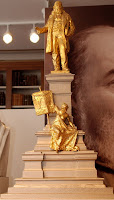Well, this isn’t actually a Presidents’ Day message. The following is a message from the Master of my lodge to the brethren of Publicity 1000 in our February trestleboard, but it’s Presidents’ Day and George Washington’s birthday, and I’m in Virginia enjoying the Washington Masonic Memorial centenary festivities, so I’m sharing this.
As America marks the birthdays of George Washington and Abraham Lincoln this month, we Free and Accepted Masons ought to celebrate these two giants on whose shoulders we still stand, so many years after they made so much history. I don’t know if there are better exemplars of the type of mature masculinity that our gentle Craft inculcates in its brethren.
You know about Washington the Freemason, the general, the president, the “Father of our Country.” Here I just want to share a little about Washington the boy. Not the cherry tree myth, but the real story of how he adopted a code of adulthood as his own. A book published in France in the seventeenth century contained a detailed list of virtues to educate boys. It was translated into English, and it was so popular that it remained available a century later, when the teenaged Washington received it in Virginia. He took it to heart and he transcribed this list of 110 maxims into his school book. We know it today as “George Washington’s Rules of Civility.”
Some examples:
No. 39 In writing and speaking, give to every person his due title according to his degree and the custom of the place.
No. 56 Associate yourself with men of good quality if you esteem your own reputation, for it is better to be alone than in bad company.
No. 109 Let your recreations be manful, not sinful.
Click here for a free copy from the George Washington Masonic National Memorial.
It all prescribes the dignified and moral conduct expected of a gentlemen of those days. Lincoln was born a decade after Washington’s death, and born into a far more humble environment than Washington, but he too is renowned today for the same unimpeachable manly character. Did you know he once fought a duel, with swords, intended as a fight to the death?
In 1842, he rebuked a public official in the wake of a government scandal. The public official challenged Lincoln to the duel. For weapons, Lincoln chose large cavalry broadswords instead of firearms, knowing he was much taller than his opponent and enjoyed a longer reach. Before anyone could be hurt, Lincoln used his weapon to hack off a tree branch, demonstrating his advantages over the other duelist. The two wisely agreed to a truce.
Years later, during the Civil War, Lincoln was president and his former adversary was a U.S. brigadier general who won an important battle and was wounded in the action. Lincoln nominated him for promotion to major general. Lincoln never was a Mason. Supposedly, he had an interest in the Craft, but the Anti-Masonic hysteria of the 1820s and ’30s dissuaded him. Washington, as you know, was initiated into the local lodge even before he turned twenty-one.
Examples of outstanding integrity from Washington’s and Lincoln’s lives are numerous because of their virtuous characters, and their public lives obviously reveal the inner men. As Freemasons, it is our challenge to labor in self-improvement and we would be wise to emulate these leaders by incorporating their qualities into our own lives.
Our world needs masculine energy, and in the spirit of masculine self-development, I encourage each of you to take time this month to reflect on Freemasonry’s Four Cardinal Virtues for your own personal growth. And consider ways to incorporate other Masonic teachings in your improvement as a husband or father or friend or neighbor. Identify personal areas where you want to grow; create plans to achieve realistic goals; and budget time to work toward success.
Remember, true self-improvement is an ongoing process, so make sure to evaluate progress and adjust plans as needed.
Let us also remember the principles of Freemasonry, such as Brotherly Love, Relief, and Truth, and strive to live by them daily. Freemasonry is more than a fraternity; it is a philosophy for living. Simply upholding our principles places us far ahead of other men on the path to becoming better men and citizens—to being good and true.
As always, I am honored to serve as your Worshipful Master, and am grateful for the dedication and commitment of each and every member of Publicity Lodge. I am proud to be a part of this fraternity and to be associated with such a great group of men. Thank you for your continued support and for being a part of our great brotherhood.





































































































